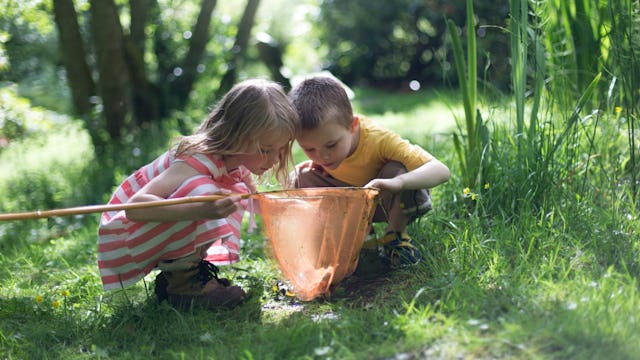Our Kids Need Time In Nature To Help Them Learn and Grow

My kids go bonkers when they’re inside all day. First they mope. Then they start to make messes — toy soldiers scattered throughout the living room, plastic dinosaur and Matchbox car battles staged wall-to-wall in the playroom.
We homeschool, and as soon as we finish, the begging starts. “Mama, can we play outside? Can we please play outside? What are we going to do today?” they ask.
The most acceptable answer is to go to a local park with several ponds. We take nets, and they stalk tadpoles (this time of year) or bullfrogs (later in the year). They catch minnows. They shout and run and leap on rocks and jump in the water. I sit under a pine tree with a book and my dog. Or we can go for a hike, preferably at a local site with a waterfall and fossils embedded in the sandstone. There are other places to hike, places where we can collect rocks or safely look for alligators, but the waterfall is their favorite.
If all else fails, we can go to one of the local splash pads, but they’re all concrete, and frankly, the kids only like them when they get hot. On the weekends, we throw them in a kayak (the 7-year-old) and a canoe (the 5- and 3-year-olds), then paddle them down a river. We do all these things because if my active sons with ADHD don’t get plenty of outdoor time, they tear my house apart. And they’re miserable in the process.
Randy Shore’s article in The Vancouver Sun says that Richard Louv, the keynote speaker of the Children and Nature Network International Conference, claims kids are more likely to report problems with attention span and with depression, and more likely to be medicated for these issues, than ever before. I know that my sons’ ADHD — and my ADD, plus my depression, for that matter — isn’t directly caused by a lack of connection to nature. Nature helps, of course. My oldest, Blaise, is always more focused and calm on the days we go out than on the days that we don’t. For that matter, I’m more focused and happy on the days we kayak than on the days we don’t.
Shore notes that a series of studies from the University of Illinois found that play in “green, outdoor spaces” aids “creative play” and helps with ADHD symptoms. I know that my kids’ favorite thing to do is to just be let loose in a green space with minimal adult supervision. They want to play with sticks (without someone shouting that they’ll poke an eye out); they want to throw pinecones and build forts and pretend to go fishing. I know they’re obsessed with water play. But as to what they’re doing, and what they’re playing, I have no idea. And I think it’s supposed to be that way. They go out into nature to create their own, child-centered space, a space without adults barking orders and wiping off cuts. Shore describes parents hovering in case anyone gets a scrape. Kids want to deal with that themselves.
Harvard University professor E.O. Wilson says we’re born with a love of the natural world, a love he calls biophilia. We’re “innately attracted to it,” and we need it for our “psychological, physical, and spiritual health.” Basically, your kids need to get out into green space, or brown space, or rock space (watch for rattlers!) or else you are going to stunt their growth and creativity. They need to make mud. They need to watch the trees move in the wind above them.
No, structured soccer practice doesn’t count. Neither do the other organized sports teams they play on. They may be outside, but they aren’t taking place in nature. Nature, by its very definition, is wild. Kids need to be let loose into its wildness to find a wildness of their own, a creativity and curiosity that matches the endless bounty around them.
Maybe you won’t let them build a fire. But they can pretend to. Maybe you don’t want to touch the tadpoles (gross), worms (even grosser), or lizards (I can live with that). But provide them with nets for humane catching and cages for humane observation. And the more children that play together, the better. As Louv says, “When kids are out with other kids, they start to play creatively, make up their own rules and games, which has virtually disappeared from the urban childhood experience.”
We may have to do a little work — finding some more kids, for example. We may have to let go of some expectations — like that Junior should be doing math homework all the time or enrolled in a sports program, and if he isn’t he deserves TV downtime. We may have to get out there ourselves. (I had to start stocking bug spray on my front porch. The tiger mosquitoes bothered me so badly I was herding my kids inside after 10 minutes.) We may have to let go of some ideas about cleanliness — mud is okay, wet is okay, dirty and sticky are okay. We may have to field some questions we don’t have the answers to (What’s that mushroom? Is that a fungus? What kind of rock is that?) But we need to get our kids outside in nature. They deserve it. For their well-being, and frankly, by extension, for ours.
This article was originally published on